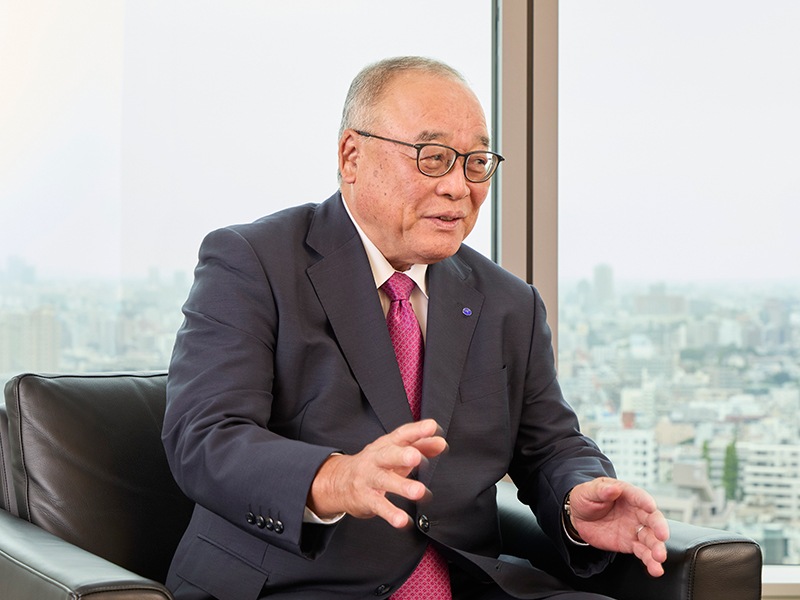Maximizing corporate value through global
group governance and diversity
Evolution of Group Governance
Fushihara: It has long been a tradition at Taiheiyo Cement that the chairman distances himself from execution and focuses solely on oversight as chair of the board. Last fiscal year was the first year under our new structure, and while there were some uncertainties, President Taura and the executive team achieved solid results. In particular, governance structures, including those covering group companies, became firmly established, and I believe it was a year in which compliance, quality, and safety visibly improved.
Koizumi: From my perspective as an independent director, I have observed the company’s management, and I particularly feel that recently group governance has become firmly established.
Group-level policies and regulations regarding governance and sustainability have been steadily developed, and are promptly revised to reflect legislative changes. Also, since the launch of the company’s intranet, highly insightful safety and sustainability slogans created by the employees themselves are displayed on their computer screens at login. I feel that these individual initiatives, taken together, contribute to strengthening governance.
Fushihara: Our group has more than 200 consolidated subsidiaries, and nearly 400 companies including affiliates. Governance of overseas subsidiaries is a particularly critical issue. At CalPortland, our U.S. subsidiary, we set up an audit department and have dispatched personnel from Taiheiyo Cement headquarters. Last year, we expanded the scope of our whistleblowing system to include overseas subsidiaries, further strengthening compliance.
Koizumi: When I first visited CalPortland in 2016, I felt a certain distance between our staff and the local employees. But when I revisited last year, I saw both sides working together with the local leadership as true “teammates.” Collaboration across the group and onsite exchanges are progressing, creating a virtuous cycle.
Embracing Diversity and Globalization

Koizumi: As the overseas share of our group’s business increases, I believe it is important to appoint foreign nationals and executives with international backgrounds to senior positions. Incorporating local opinions and perspectives into management improves the quality and speed of decision-making, and enhances competitiveness as a global company. With the advancement of online meetings and interpretation technologies, geographical distance is no longer an obstacle. For example, we might start by appointing such individuals as executive officers and then gradually expand.
Fushihara: I completely agree. With nearly half of our profits now generated from global business, localization of management and the integration of diversity at headquarters are indispensable. It is time for the board to begin serious discussions on how to incorporate local leaders and experts into management.
Koizumi: There is also much to learn from overseas in terms of risk and crisis management. For example, global companies not only establish rules for emergencies but also conduct simulation drills in preparation. Our group has conducted similar drills before, but by referencing local practices, we can enhance their effectiveness in times of crisis.
Deepening Supply Chain Management and ESG

Fushihara: With group governance now on track, our next challenge is supply chain management. We have established a basic purchasing policy that sets out our expectations for responsible conduct in the supply chain. Going forward, we must strengthen governance across the entire supply chain by promoting understanding through ongoing dialogue with suppliers and providing support where necessary.
Koizumi: Our group has positioned carbon neutrality as a core strategy, and achieving it requires the cooperation of the supply chain. Furthermore, with the enforcement of the Freelance Law, contracts and working conditions for freelancers must be properly managed. Many sole proprietors are part of our supply chain, so this will become an important topic in supply chain management.
Maximizing Corporate Value and the Future of Taiheiyo Cement
Fushihara: Anticipating long-term declines in domestic cement demand, we began overseas expansion more than 30 years ago. In Japan, we are also exploring new business fields, such as participating in a large-scale dairy farming facility in Fukushima. Under the 26 Medium-Term Management Plan, we aim to achieve “¥1 trillion in net sales, ¥100 billion in operating profit, and 10% ROE,” but this is only the first step. We must not pause there; instead, we aim to sustain our growth trajectory—targeting, for example, ¥2 trillion in net sales and ¥200 billion in operating profit. To achieve this, we must carefully discuss with management what needs to be done both domestically and internationally, and present a 10-year growth strategy to stakeholders as soon as possible.
Koizumi: I feel that our employees sincerely embody the management philosophy of being “a pioneer in creating a sustainable future for our planet.” Their emphasis not only on economic growth but also on environmental and social contribution is a corporate culture we can proudly share with the world. I hope that, by continuing to cherish this philosophy, we will pursue management that is diverse and open to all stakeholders.
